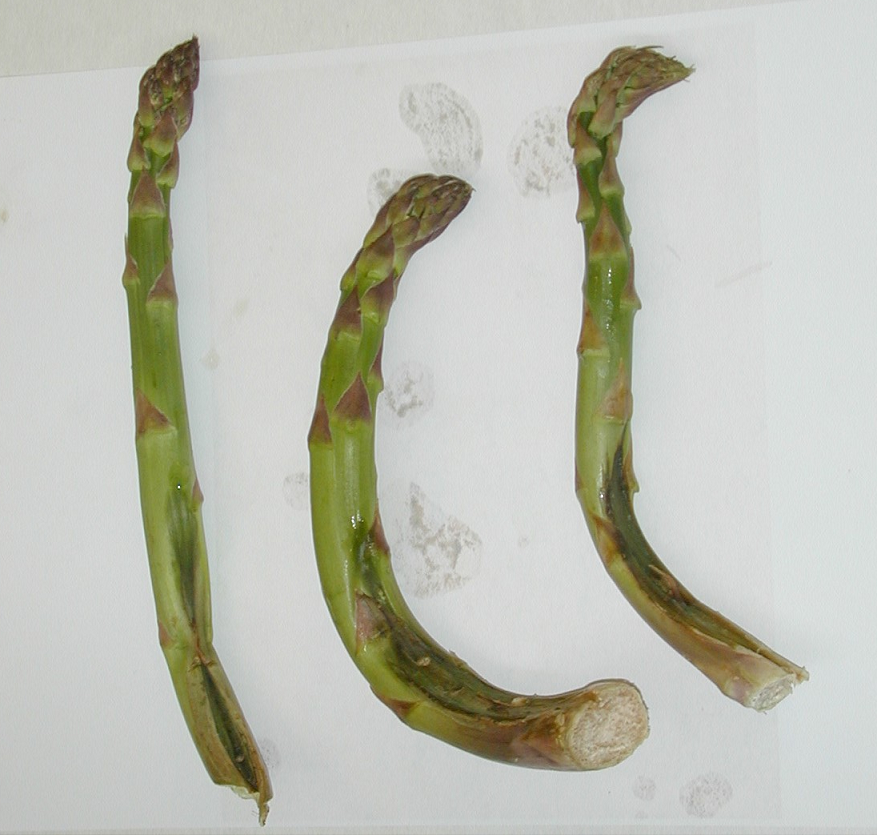Please click here to access the main AHDB website and other sectors.
Phytophthora rot in asparagus – be aware and prepare
Wednesday, 24 March 2021
With the UK asparagus season fast approaching, Kim Parker explains how visible symptoms of phytophthora rot are the ‘tip of the iceberg’ and summarises strategies for prevention and control.
For some asparagus growers, phytophthora rot is a familiar ‘foe.’ Other growers first encountered this devastating disease in 2020, following a mild wet autumn and saturated soils in February.
What are the symptoms of phytophthora rot in asparagus?
The most obvious symptoms of asparagus phytophthora at harvest are lesions at the spear base. These result in spear twisting or a characteristic ‘crooked’ appearance, followed by collapse or shrivelling. Often, however, the only indication of a problem is fewer spears emerging, thin spears, or increasingly poor plant stands.
The progress of phytophthora becomes more obvious once you dig down to the roots and crown. Infected roots first appear water-soaked, then later brown and rotted. Infected crowns have softened internal tissues.
Damage provides entry points for other pathogens such as Fusarium species. As a result, there can be a long-term damaging effect on spear and fern production and yields in the following seasons.

Back to: Integrated pest management (IPM)
How does the phytophthora rot pathogen survive?
The pathogen can survive in crowns for planting and as long-lived ‘oospores’ in the soil. Swimming spores are released from pathogen structures in crown tissue and oospores in soil, leading to infection of roots and emerging spears.
The optimum temperatures for infection are 10–12oC. Severe attacks are associated with wet conditions and poor drainage.
How do I manage phytophthora rot in asparagus crops?
Prevent
Phytophthora is difficult to eliminate once it is present in a field, so prevention is the best strategy:
- Avoid new plantings where there is a history of root rot on a previous crop
This can indicate that soil conditions may be conducive for development of phytophthora rots.
- Ensure that soil is well-drained and not prone to waterlogging
If there is poor drainage in a mature crop, take action to remedy the problem.
- Check with crown suppliers that propagation areas are free from phytophthora rots
Note that there is currently no diagnostic test used commercially to check for phytophthora in crowns.
- Crown planting should be done under dry, warm conditions
This should minimise the risk of phytophthora infection.
- Consider zero tillage
Cultivation practices such as annual ridging and sub-soiling can cause root damage and entry points for infection by the pathogen. Results from our research have led to new thinking on the potential benefits of zero tillage.
Understanding asparagus root growth patterns: watch the video & read the factsheet
Control
SL 567A (metalaxyl-M) is the only fungicide currently approved for phytophthora rot management on asparagus and has to be applied before spears emerge.
SL 567A is most effective when applied to moist soils and then ‘washed’ into the soil with an advancing front of water from rain. The product should not be applied to saturated soils as it can be easily removed by surface drainage.
As the industry relies on a single active substance, metalaxyl-M, we are concerned about the risk of resistance. There is also the possibility of reduced efficacy because of microbial degradation in the soil. We are, therefore, working with industry to explore other fungicide options.
An indepth look at phytophthora rot in asparagus - symptoms & management options
Crop Walkers' Guide: Asparagus - identify key pests & diseases
Sustainable control methods for asparagus beetle
SCEPTREplus trial results for asparagus crops
Kim Parker has worked in UK horticulture since 2000. She has been a Crop Protection Scientist (Diseases) at AHDB for over four years, focusing on field vegetables and protected edibles and previously worked as a plant pathologist for ADAS

